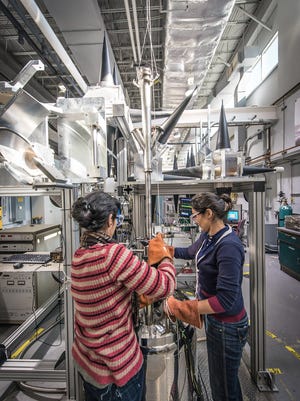FSU’s MagLab receives $195 million in fundingFlorida State’s National High Magnetic Field Laboratory, or MagLab for short, has received over $195 million in funding from the National Science Foundation.
— FSView & Florida Flambeau (@FSView) January 23, 2023
Check out how this will allow the cutting-edge program to function and grow at FSU. pic.twitter.com/n9BDkPrmiM
Florida State is home to the world’s largest magnet and hosts around 2,000 scientists who use the University's magnets. The new funding allows grants for instrumentation and support from partner institutions for the MagLab to function.
“This achievement is really a team effort by dozens, if not a hundred individuals. It’s a multiyear effort and that's why we celebrate,” said Boebinger.
The MagLab will be hosting an open house on Saturday, February 25 from 10a.m.-3p.m. for anyone interested in learning about this unique laboratory. For more information visit the MagLab at https://nationalmaglab.org/
The $195.5 million grant is 6 percent above the last grant. And while its awarding was never seriously in doubt, Boebinger said its denial would have meant the end of the line for the world-famous research center.
"We use that to build other initiatives and have even broader impacts. So, if you will, this is the central pillar around which we build the rest of the cathedral."
National MagLab headquartered at FSU receives $195 million in funding for the next 5 years
The National High Magnetic Field Laboratory — the world’s most powerful magnet lab that also calls Florida State University home — recently received $195.5 million for the next five years.
Increasing the MagLab’s funding levels by 6%, the money from the National Science Foundation will allow the lab to continue supporting groundbreaking discoveries using high field magnets.
“While the lab serves a fundamental purpose of furthering knowledge, it also plays an important role in working with industries to enhance available technologies in areas such as magnet manufacturing, MRIs and more,” FSU Vice President for Research Stacey Patterson said in a prepared statement.
Groundbreaking discoveries made through the MagLab since its establishment in the early 1990s range from changing the way people store and deliver energy by developing better batteries to using the world’s strongest MRI magnet for improvements in the treatment of diseases like AIDS, cancer and Alzheimer’s.
One of the lab’s recent accomplishments was discovering that a mini magnet less than four inches in size broke a record for magnetic field strength, which could be used for objects across fields like physics, materials science, chemistry, biology and engineering.
Research done at the laboratory is possible with the help of over 30,500 physicists, chemists, biologists and engineers from 54 countries that the lab has hosted since it was established. Over 1,700 scientists use the laboratory for research every year.

“The MagLab research portfolio touches so many of today’s major scientific challenges,” MagLab Director Greg Boebinger said in a prepared statement. He is also a professor at FSU and was selected last year to be a member of the National Academy of Sciences for his career in physics.
“High magnetic fields are revealing new materials for quantum technologies, combatting climate change, protecting human health, enabling the magnet-based machines of the future and paving the way to new energy solutions,” Boebinger added.
Being a taxpayer-funded facility, the MagLab is expected to generate about $6.5 billion in economic activity and over 53,600 jobs in Florida over the next 20 years, according to a report by the Center for Economic Forecasting. It also generates about $6 of economic activity for every state dollar invested in the facility.
No comments:
Post a Comment